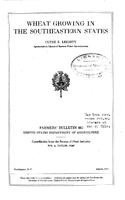Browse Items: 4
Page 1 of 1
Experiments With Fall-Sown Oats in the South
It is recognized that fall-sown oats succeed better than spring-sown oats in most districts of the South. The one disadvantage which has retarded the growing of the crop more than any other has been occasional loss by winterkilling. The development of hardier and otherwise more satisfactory varieties and the determination of better cultural…
Winter Oats for the South
Only a small portion of the area of the Southern States is devoted to the production of oats. The average production for the past ten years of 16 States was about 870,000,000 bushels, or 8.5 per cent of the crop of the United States. The average acre yield was 21.8 bushels and the average acre value $10.09.
Winter oats are a valuable crop for…
Winter oats are a valuable crop for…
Barley Culture in the Southern States
Barley, although it ranks fourth among the cereals in the United States, is but little cultivated in the South for grain.
As a true awnless barley has been developed the word "hooded" is proposed for the beardless barleys now grown.
The Tennessee Winter variety is the most profitable barley to grow in the South.
Winter hooded and spring…
As a true awnless barley has been developed the word "hooded" is proposed for the beardless barleys now grown.
The Tennessee Winter variety is the most profitable barley to grow in the South.
Winter hooded and spring…
Wheat Growing in the Southeastern States
THE FARMERS in the six Southeastern States- Tennessee, North Carolina, Mississippi, Alabama, Georgia, and South Carolina are encouraged to increase their wheat acreage on land suitable for the crop, as it leads to crop diversification and provides home-grown bread.
The sandy loam, silt loam, loam, and many of the clay soils when well drained…
The sandy loam, silt loam, loam, and many of the clay soils when well drained…
Page 1 of 1
 An official website of the United States government.
An official website of the United States government.





